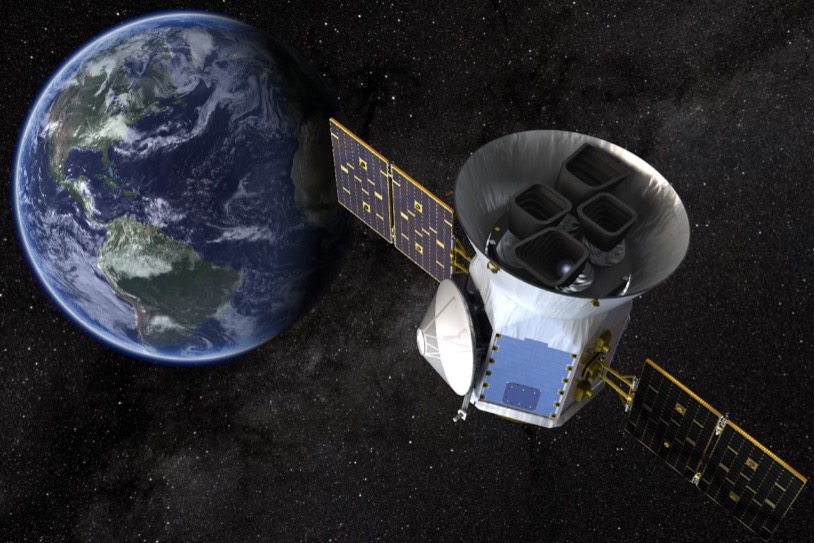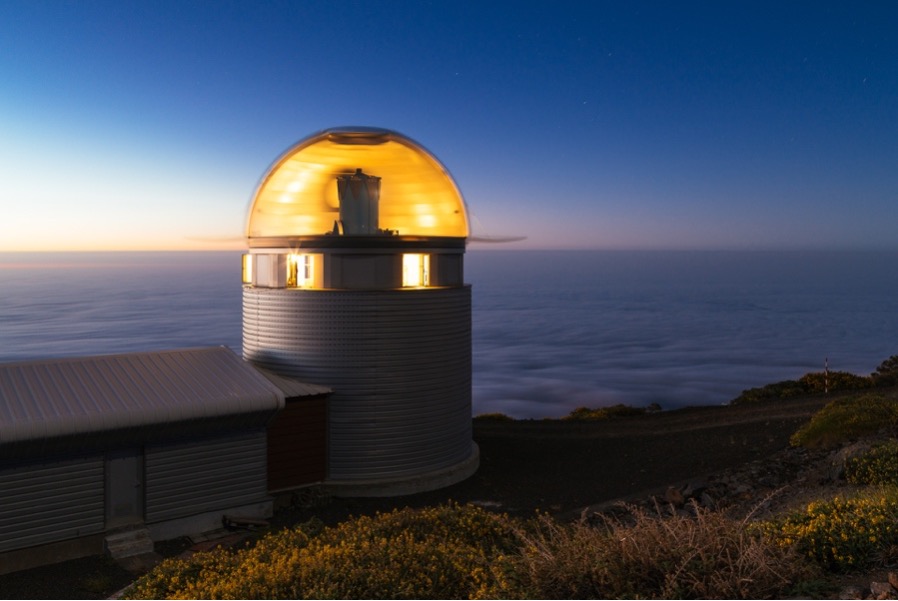The study, led by Dr. Siemen Burssens of KU Leuven, Belgium and published in Nature Astronomy, applied the technique of asteroseismology to study the variability of a newly discovered pulsating star known as HD 192575.
Asteroseismology is the study of waves inside stars and allows astronomers to glimpse behind the dress rehearsal curtain drawn by the opaque stellar surface of a star. Indeed, almost all stars in the Universe are variable stars, changing their intrinsic brightness because of waves generated inside their interiors. These waves are affected by a star's interior rotation and core structure, allowing astronomers to understand the physical processes responsible from observing its graceful pirouettes and play of light on the sky. These physical processes currently remain uncalibrated yet need to be understood to predict the ultimate fate of the star.

Figure 1. Conceptual illustration of NASA's Transiting Exoplanet Survey Satellite (TESS),
which observed the light variations of HD192575. Image credit: NASA's Goddard Space Flight Center.
From the variability discovered in the high-precision and long-duration light curve assembled by NASA's TESS mission (see Figure 1), Dr. Burssens and his colleagues achieved unprecedented high precision in determining the age and mass of HD 192575:
« Space telescopes like TESS, and Kepler before, are able to observe stars almost uninterruptedly for long periods of time, making them excellent tools for asteroseismologists », says Dr. Siemen Burssens (KU Leuven). « TESS is especially important for asteroseismology of massive stars, since previous space telescopes generally avoided bright massive stars. »
The novel modelling tools developed in this work allowed Dr. Burssens and his team to measure the mass of HD 192575 to be 12 times the mass of our Sun, and an age of 15 million years. This makes HD 192575 one of the rarest and most massive stars to have ever been modelled using asteroseismology, since such stars are extremely short-lived in the Universe.
Moreover, a fundamental constraint in the analysis was to independently determine the radius of the star using a method that is both powerful and simple, based on interferometry. « Interferometry is a technique developed on the Côte d’Azur 50 years ago and which makes it possible to measure the angle under which we see the stars. This extremely small angle corresponds to the angle under which we would see a pea at the other end of France, or equivalently, a man on the Moon. Because HD192575 is angularly too small to be measured directly by interferometry, we used a remarkable tool, a color surface brightness relationship, calibrated by interferometry, to establish the radius of the star to be about 8 times the radius on Sun », specifies Nicolas Nardetto, CNRS researcher at the Lagrange Laboratory (Université Côte d'Azur-Observatoire de la Côte d'Azur-CNRS).
All these constraints were useful to show that, the nuclear-burning core of HD 192575 was discovered to rotate about 1.5 times faster than its surface layers, which is not predicted by current models. These results are crucial in understanding the laws of physics that govern the interior rotation history of such stars, from birth until death as supernova explosions when they form neutron stars and black holes.
« Like a ballet dancer who spins faster by bringing their outstretched arms closer into their body, HD 192575 should have a core that is spinning up as it gets older and shrinks. However, the core's rotation rate we measure today is not as fast relative to its outer layers as predicted by rotating non-magnetic models, » says Dr. Dominic Bowman (KU Leuven), co-author of the study. « This has led us to ponder what physics is responsible for HD 192575 having its measured rotation profile. »

Figure 2. The Mercator telescope in La Palma, Spain. Data from the telescope was essential
in unravelling the interior structure of HD192575. Image source: www.mercator.iac.es (KU Leuven)
In addition to new TESS light curves, data from the KU Leuven Mercator telescope (see Figure 2) and ESA's Gaia space mission were essential in unravelling the interior rotation profile and determining a precise mass and age for HD 192575. It was the unique combination of the different sources of data that allowed the team to also infer the amount of chemical mixing accurately deep inside HD 192575 and infer its core mass, which is a key predictor of a massive star's future evolution and supernova explosion. This is especially important given that only a handful of massive stars have been studied asteroseismically before now. The combination of an accurate core mass and rotation profile make HD 192575 a truly unique calibration point for stellar evolution theory.ge unique pour la théorie de l'évolution stellaire.
« While we have been able to provide the first asteroseismic characterisation of HD 192575, there is still an abundance of information in its observed waves, which we plan to utilise using additional theoretical frameworks that are currently under development, » says Dr. Siemen Burssens.
But the work doesn't stop there. The precise core mass, age, and rotation profile of HD 192575 are invaluable inputs to stellar evolution models for constraining interior magnetic fields and transport processes, but also galactic evolution models. HD 192575 is unique in its properties for the time being, but NASA's ongoing TESS mission is continuously providing high-quality data for thousands of massive stars of different masses and ages. The amount of asteroseismic studies for massive stars is expected to increase dramatically in the coming years.
« Providing a much clearer map of massive star evolution using TESS data of variable stars is now within reach thanks to our proof-of-concept study on HD 192575, » concludes Dr. Dominic Bowman.
The team led by Dr. Siemen Burssens (KU Leuven) includes researchers from Belgium, Spain, France, Poland, and the USA, and was published in Nature Astronomy on 22 June 2023.CNRS researcher Nicolas Nardetto's contribution was to determine the star's radius using an indirect method based on interferometry, a cutting-edge technique in which the Lagrange Laboratory at the Côte d'Azur Observatory has historically been an expert.
Funder details
- Conseil européen de la recherche (ERC-AdG 670519 ; MAMSIE)
- Fondation flamande pour la recherche (1286521N, 11F7120N, et 1156923N)
- Conseil de la recherche de la KU Leuven (C16/18/005 ; PARADISE)
- Gouvernement espagnol Ministerio de Ciencia e Innovación (PGC-2018-0913741-B-C22 et PID2021-122397NB-C21)
- Agence canarienne pour la recherche, l'innovation et la société de l'information et Fonds européen de développement régional (ProID2020010016)
- Fondation nationale de la science (ACI-1663696)
- NASA (80NSSC20K0515)
- NCN polonais (2015/18/A/ST9/00578 et 2021/43/B/ST9/02972)
- Nationale de la Recherche (ANR-21-CE31-0018-02)
Paper details
« A calibration point for stellar evolution from massive star asteroseismology » in Nature Astronomy, 22th june 2023.
Contact
Nicolas Nardetto, chercheur CNRS, au laboratoire Lagrange (Université Côte d’Azur – Observatoire de la Côte d’Azur – CNRS) - nicolas.nardetto@oca.eu.






